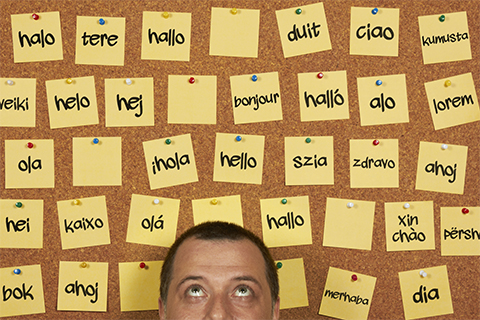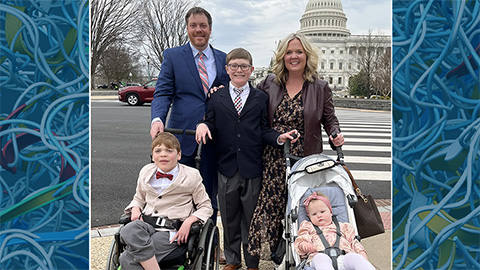
The language barrier: Daily struggles of an immigrant in science
During my early childhood in Brazil, I heard the English language in movies, music and television shows. Anything with a science fantasy theme captivated me, and “Jurassic Park” inspired me to pursue a career in science. I was fascinated by the cutting-edge film technology, especially when combined with scientific questions about cloning and genetically engineered dinosaurs. These sparked my interest in genetics, biochemistry, molecular biology and paleontology, tapping into my desire to explore the unknown.
When I grew older, my parents enrolled me in English classes at a local language school. I dedicated about 10 years to studying the language. Then I traveled to Cape Town, South Africa, to take more English classes and do volunteer research with white sharks. Despite all those years of classes in Brazil, when I arrived I couldn’t ask a cabby to take me to the right place. That first taxi ride cost me a lot of money. I realized true fluency would come from immersing myself in real-life situations. To learn a language, I needed to venture out, take risks and be willing to make mistakes.

I was just beginning my scientific career as an undergraduate in the microbiology and cellular biology laboratory at the University of Sao Paulo. My South Africa experience opened my ears and fueled my determination to achieve greater fluency in English. In the lab, I transitioned from reading research papers to presenting findings at conferences, always striving to use and understand the authentic English language.
Today, as a postdoc in the U.S., I still dedicate extra time to deciphering complex scientific texts, translating thoughts into English and practicing presentations to ensure clarity and coherence. It usually takes me twice as long as a native English speaker to read and understand a paper, and crafting a coherent response also demands significantly more time. Other people often misinterpret this added time and effort needed to process information in a second language. They view it as indicating a deficiency in intelligence or basic knowledge. I have faced this during paper discussions in group meetings or when conversing with lab colleagues about a recent paper we are reading. These experiences often leave me feeling frustrated and isolated.
We nonnative English speakers often require additional time to process information in English, particularly in high-stakes situations such as responding to questions from supervisors or mentors about experiments or data analysis. We need patience, empathy and understanding from our peers and colleagues. We try to comprehend and integrate into English-speaking environments, but misunderstandings, errors or communication breakdowns prevail.
During group conversations, understanding a second language requires concentration and attention. With multiple people talking, it is nearly impossible to keep up with all the subjects being discussed. This frequently occurs during poster presentations and coffee breaks at conferences, but I’ve developed a strategy to manage it.
First, I avoid participating actively. I usually don’t have time to formulate a coherent response before someone else speaks, so I listen and try to follow the conversation. Also, I always like to have a good friend with me who is a native speaker and can later summarize what was discussed. It’s disheartening to rely on another person to understand a conversation, but that is the reality for millions of people in this country. Fortunately, many understanding, patient and caring people will offer their support and help.
The language barrier can impact immigrants' confidence in our abilities. Because I’m afraid of being misunderstood or judged for my accent or grammar mistakes, I sometimes hesitate to speak up in meetings or share my ideas with colleagues.
At the 2024 annual meeting of the American Society for Biochemistry and Molecular Biology in San Antonio, Texas, I attended several engaging and exciting talks. One speaker particularly captivated me, and I was eager to ask questions or speak with him after his presentation. Do you know why I hesitated? Because he was American, and I felt embarrassed to speak English with him. However, I mustered up the courage and approached him after his presentation, and I'm glad I did. We had a great conversation about his research, and he was supportive and encouraging.
Reflecting on this experience, I realize that it aligns with the idea of venturing out, taking risks and being willing to make mistakes. Despite my initial hesitation, stepping out of my comfort zone led to a positive and enriching interaction and a great networking opportunity.
Overcoming language barriers and building confidence can unlock valuable opportunities for learning and professional growth. While initial hesitation might seem silly, such moments highlight the barriers that exist for nonnative speakers. Our lack of confidence can be detrimental to our professional growth and may prevent us from fully contributing to scientific discussions and collaborations. In this scenario, science loses.
To address these challenges, universities, institutions and scientific societies need to implement more inclusive practices and policies. These include providing support services tailored to the needs of immigrant scientists, such as language classes, writing workshops and mentoring programs with accessible prices. Some universities have been doing an excellent job in this regard, such as Penn State Behrend, Rice University, Brandeis University, the University of Alabama, Indiana University, the University of Colorado Boulder and Purdue University Indianapolis.
Fostering a culture of inclusivity and diversity within the scientific community can help create an environment where immigrant scientists feel valued and respected. Cultural competence training, supportive infrastructure, and advocacy for representation are essential. I’d like to see university-wide events and scientific conferences featuring nonnative speakers as spotlight presenters, sharing their findings and discussing their thoughts about science. This would help us feel more comfortable and appreciated.
Universities need to reevaluate their graduate and postdoc training programs, with a focus on offering tailored science communication courses for nonnative speakers. Many institutions now offer classes in science communication, but I don’t know of any that are aimed at those of us for whom English is not a first language. These courses could include exercises aimed at summarizing scientific findings, critically reviewing existing literature and refining oral presentation skills.
A course would serve as a foundational step, but self-improvement through consistent reading habits and listening to narrative podcasts also can sharpen language skills. I recommend the Science Podcast from the American Association for the Advancement of Science where guests include Science’s online news editors and authors of papers and news stories published in Science and its sister journals.
By recognizing and working to overcome language barrier challenges, we can create a more inclusive scientific community that fully utilizes the talents and contributions of immigrant scientists. It is the responsibility of all stakeholders in the scientific community to ensure that language does not hinder success in science. We should all take responsibility for that.
Enjoy reading ASBMB Today?
Become a member to receive the print edition four times a year and the digital edition monthly.
Learn moreGet the latest from ASBMB Today
Enter your email address, and we’ll send you a weekly email with recent articles, interviews and more.
Latest in Opinions
Opinions highlights or most popular articles

Debugging my code and teaching with ChatGPT
AI tools like ChatGPT have changed the way an assistant professor teaches and does research. But, he asserts that real growth still comes from struggle, and educators must help students use AI wisely — as scaffolds, not shortcuts.

AI in the lab: The power of smarter questions
An assistant professor discusses AI's evolution from a buzzword to a trusted research partner. It helps streamline reviews, troubleshoot code, save time and spark ideas, but its success relies on combining AI with expertise and critical thinking.

How AlphaFold transformed my classroom into a research lab
A high school science teacher reflects on how AI-integrated technologies help her students ponder realistic research questions with hands-on learning.

Writing with AI turns chaos into clarity
Associate professor shares how generative AI, used as a creative whiteboard, helps scientists refine ideas, structure complexity and sharpen clarity — transforming the messy process of discovery into compelling science writing.

Teaching AI to listen
A computational medicine graduate student reflects on building natural language processing tools that extract meaning from messy clinical notes — transforming how we identify genetic risk while redefining what it means to listen in science.

What’s in a diagnosis?
When Jessica Foglio’s son Ben was first diagnosed with cerebral palsy, the label didn’t feel right. Whole exome sequencing revealed a rare disorder called Salla disease. Now Jessica is building community and driving research for answers.

